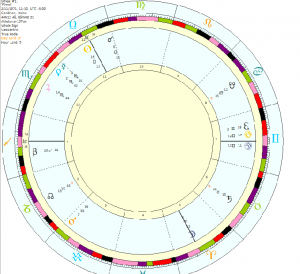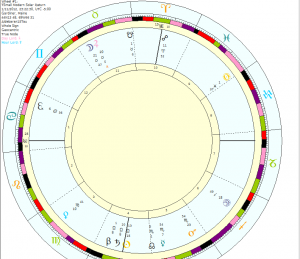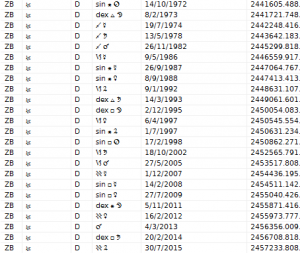One of the most widespread time-lord techniques in Hellenistic astrology is referred today as annual profections. The Hellenistic astrologers did not have a specific name like most of their techniques, although some refer to a method for “determining the lord of the year”. There are many variations of the so-called annual profections that do not focus on a single houseruler, and for the most part there is lack of agreement on how to calculate monthly, daily and hourly types of profection.
Annual Profections
The earliest surviving reference to profections is found in the third book of Astronomica by the Roman poet Manilius. According to Manilius, the first year belongs to the sign of the Sun, while the next and subsequent years belong to the signs that follow in zodiacal order. The rationale given by Manilius for using the Sun is that it takes one year for the Sun to complete one course. This method to annual profections seems to be unique to Manilius.
The Anthology by Vettius Valens contains an abundance of different time-lord procedures. One chapter, attributed to a “Hermetic” source (Valens, 4.27) also suggests counting from the Sun, although only when it is found at an angle. This chapter describes a predomination method that considers four possible releasing places. If the Sun does not happen to be angular, one begins from the Moon if it is at the “degree of an angle”. If both are inapplicable, one begins from the Lot of Fortune if it happens to be angular. If all three points are inapplicable as specified, one counts from the Ascendant. If both luminaries are “approaching the angles“, one should start counting from the luminary that is of the sect in favour. The remaining of the chapter describes more predomination rules, although the passage is short and fragmentary.
Manilius states that some approved of an alternative approach where they counted years, months, days and hours from the Ascendant. This is the most common method of annual profections in the Hellenistic tradition and remained such in the Arabic tradition. It is mentioned by Dorotheus of Sidon, Firmicus Maternus, Paulus Alexandrinus and Hephaistio of Thebes. David Pingree translates the Arabic passage of the fourth book by Dorotheus as follows:
When a native is born, the lord of the year is the lord of the house [ascendent] in which the native was born. Thus count from the ascendent a year for each sign until you reach the year which you desire; the lord of that house is the lord of the year. Look at the lord of this sign, whether it is a benefic or a malefic, and in the base nativity how its position was and in which foundation it was. From the base-nativity is known what is concerning him [the native] at the beginning of the year, and the beginning of the year is always when the Sun enters the beginning of the minute in which it was on the day of the native's nativity. (Pingree, Dorotheus, 4)
Although Firmicus Maternus (Mathesis, 2.27) states that one should count from the rising sign, he mentions that some astrologers count from the Sun for day births, and from the Moon for night births. This presents additional evidence for counting from other places besides the rising sign based on considerations of predomination. Claudius Ptolemy in book 4, chapter 10 of the Tetrabiblos also describes annual profections from each of the releasing places he outlines previously in the same chapter. Rhetorius of Egypt in chapter 54 of the Compendium also mentions releasing not only from the Ascendant, but also from the Sun, the Moon, and the Lot of Fortune. A brief passage in CCAG 2.212.30-213.1 mentions Rhetorius in relation to counting from the parents’ lots for that topic.
Most astrologers focus on the planetary condition of the domicile ruler of the sign the year has come to. Some astrologers such as Dorotheus and Rhetorius also mention examining the sign and its configurations, and transits in relation to the quality of the year. In Books 4, 5 and 6 of the Anthology, Valens introduces a more complex method of profections, which evidently is partially derived from a lost work of an earlier author known as Critodemus.
The summary of Cridodemus (CCAG 8.3.102) mentions briefly that he dealt with the giving over (paradosis) of one planet to another, which sounds similar to the delineations given in Anthology 4.17-24. This does not represent conclusive evidence that Vettius Valens took his delineations for annual profections from Critodemus since the consideration of which planet is imparting to another is also used in the exaltation method of Balbilus, decennials (referred to as the method of dodekatemoria by Valens) and ingresses. Thus the chapters on the effects of the transmissions of the Ascendant, the planets, and the four lots in Valens could be unique to him.
According to Valens, one can profect from every planet, place and lot, and not just from the Ascendant, although he does emphasize the luminary of the sect in favour, the Ascendant and the other luminary. What seems to be different from other authors, is that the planets that occupy the sign take over the role of the houseruler. The releaser handles over the year to the houseruler only if the sign is empty.
In Book V, Valens introduces an elaboration of the previous rationale. The giving over of one point to another is also active in the years of the native that are multiple of the distance of signs, both taken as ordinal numbers. For example an Ascendant in Virgo would profect to Mars in Libra every second year from birth, and to Jupiter in Sagittarius every fourth year from birth. Both Valens and the Liber Hermetis credit Critodemus for a table of numerical profections of the Moon in relation to health crises. Critodemus emphasizes profections to planets in years which are multiple of 3 for Saturn, 9 for Jupiter, 7 for Mars, 18 for the Sun, 5 for Venus, 8 for Mercury and 13 for the Moon. The rationale behind those numbers is unknown. Valens says that if the year is not composite, one should extend the preceding interval as active for that given year.
Another method attributed to Hermes (Valens, 4.29) says that one should count from the Sun for mental matters, from the Moon for physical matters and the mother, and from the Lot of Fortune. These texts indicate that approaches to annual profections in the Hellenistic tradition were quite varied and often few starting points were used depending on the topic. Hermes states that one should use the Sothic year, which was equivalent to the year mentioned in Dorotheus.
Monthly Profections
There is even greater difference of opinion when it comes to monthly profections, perhaps partially because of disagreement on what period of time constitutes one month. Manilius states that one should begin counting from the Moon, and the rationale given is that it takes one month for the Moon to complete its course. Strangely, given his rationale for annual profections, Manilius later implies that there are 12 months in a year. Perhaps “course” is meant in the sense of an approximate or idealized synodic month rather than as the length of a sidereal month.
Most manuscripts of the Tetrabiblos present 28 day monthly profections, albeit from the sign the year has come to. This makes the domicile ruler of the sign assigned the year - time-lord over the first and the thirteenth month of that year. 28 days approximates the lunar month, and 13 months make 364 days which is approximately the length of the year. In the Arabic tradition, Al-Biruni describes monthly profections as consisting of 28 days 1 hour and 51 minutes to make it align with the 365 day year. Only two conflicting MSS. of the Tetrabiblos describe profections using 30 day months (Robbins, 1940).
Paulus and Hephaistio also describe profecting every month from the sign assigned the year, although they do not specify the length of the month. Since Hephaistio specifies that the daily profections are counted every two and one half days, it seems reasonable to make the assumption that he meant a year consisting of 12 months, each comprising approximately 30 days. This variation became the most prevalent one in the Arabic, Medieval and Renaissance traditions.
This approach of counting signs from the profected signs seems relatively absent in the rest of the Hellenistic tradition and its later popularity may have been partially influenced by Ptolemy. Most of the earlier authors present lot-like calculations for finding the sign of the month. One variant (Valens, 4.29) has a brief passage attributed to Hermes which says to take the distance from the transiting Sun to the Moon at the nativity, and then count the same distance from the sign assigned the year (profected Ascendant).
Similar calculation is later attributed to Nechepso by Valens (Anthology, 5.4), although it counts from the Ascendant of the nativity instead of the profected Ascendant. Levente László in private communication affirmed that the translation by Robert Schmidt and Mark Riley on the second part of the passage are mistaken. Schmidt and Riley both mistook the calculation being given for the operative “days” (τὰς δὲ ἡμέρας) for implying reversal of the monthly calculation for “day” births. This translation is also inconsistent conceptually, since it would imply that the diurnal calculation is thirteen times faster than the nocturnal calculation.
Firmicus Maternus (Mathesis, 2.28) does not even mention monthly profections. Instead, he describes an alternative technique using a division of the year. Beginning with the lord of the year, one assigns the days of the year among the planets following in zodiacal order, each star given a specific amount of days in proportion to its minor recurrence years. In other words, the year is divided by the sum of the minor years and multiplied by the minor years of each star. Annual divisions are also described by Valens (Valens, 4.30) and Hephaistio (Apotelesmatics, 2.36) with slight variations of the exact length of time because only Valens calculates the hours.
Hephaistio mentions an alternative division in which each sign is assigned the minor years of the domicile ruler, beginning from the sign that is given the year, although Saturn is assigned only 30 days, with the reasoning given by Hephaistio is that the two domiciles of Saturn are adjacent. After 184 days, the same division is repeated until the year is completed. Valens mentions that some astrologers made “monthly” forecasts according to the houserulers of New and Full Moon, although his opinion is that the transiting Sun foretells the outcome of the month due to arousing the power of signs and time-lords (Anthology, 5.4).
Daily and Hourly Profections
Few astrologers describe daily profections and even fewer mention hourly profections. Manilius says one should count daily and hourly profections from the Ascendant with each sign being given a day twice a month (2 1/2 days?) and one hour once a day. Goold (1977) suggests that double-hours are meant, rather than planetary hours.
Ptolemy uses 12 daily profections in a month with most MSS. giving the length of 2 1/3 days, while only those that give the 30 day monthly profections report a length of 2 1/2 days. Paulus also says that one should count daily profections from the sign assigned the month, albeit every sign given one day rather than 1/12 of a month. Hephaistio gives the length of 2 1/2 days.
Valens describes a method of multiplying the years of the nativity by 5 1/4, adding the days from birth, and dividing the result by twelve, giving one to each sign. He says that some astrologers count from the sign just following the Moon. This handy calculation yields one sign per day. Dorotheus gives a lot-like formula, saying one should measure the distance from the transiting Sun to the transiting Moon, and the same distance from the Ascendant at the nativity.
Different calculation is attributed to Nechepso by Valens (Anthology, 5.4). The operative day is determined by counting from the transiting Moon to the Sun at the nativity, and then the same distance from the Ascendant. The length of these two profections vary according to the speed of the Moon. Perhaps the appeal of these lots is that they dispense with the ambiguity of calendars and are instead based on concurrent astronomical positions and planetary revolutions.
Bibliography
Dorothei Sidonii Carmen Astrologicum, ed. David Pingree, Teubner, Leipzig, 1976.
Firmicus Maternus, Ancient Astrology, Theory and Practice: Matheseos Libri VIII, trans. Jean Rhys Bram, Noyes Press, Park Ridge, New Jersey, 1975.
Greenbaum, Dorian Gieseler (trans.), Late Classical Astrology: Paulus Alexandrinus and Olympiodorus, with the Scholia from Later Commentators, ed. Robert Hand, ARHAT, Reston, VA, 2001.
Hephaistio of Thebes, Apotelesmatics, Book II, trans. Robert H. Schmidt, The Golden Hind Press, Cumberland, MD, 1998.
Kraus, P. al-Biruni: The Book of Instruction in the Elements of the Art of Astrology, transl. by R. Ramsay Wright (Book Review). Orientalistische Literaturzeitung, 38, 692, 1935.
Manilius, Astronomica, ed. and trans. G. P. Goold, Loeb Classical Library, Harvard University Press, Cambridge, MA, 1977
Pingree, David, Vettii Valentis Antiocheni anthologiarum libri novem, B.G. Teubner, Leipzig, 1986.
Ptolemy, Tetrabiblos, ed. and trans. F. E. Robbins, Harvard University Press, Cambridge, MA, 1940.
Rhetorius the Egyptian, trans. James Herschel Holden, American Federation of Astrologers, Tempe, Arizona, 2009.
Schmidt, Robert (trans.) and Robert Hand (ed.). The Astrological Record of the Early Sages in Greek, The Golden Hind Press, Berkeley Springs, WV, 1995.
Vettius Valens, The Anthology, Book V & VI, trans. Robert Schmidt, ed. Robert Hand, The Golden Hind Press, Cumberland, MD, 1997.
Vettius Valens, The Anthology, trans. Mark T. Riley, online, December, 2010.











